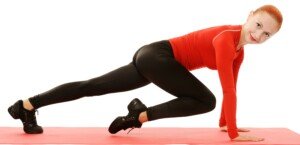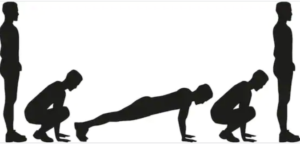If you have or had snapping hip syndrome, you’ll want to know the five exercises to avoid to keep it from getting worse or help prevent a recurrence of this tendonitis.
The inflammation typically involves the iliopsoas muscle or iliotibial band.
It can take many months of consistent therapy exercises to calm down the inflamed tendon in “dancer’s hip.”
This condition is called snapping hip syndrome due to the popping and cracking noise that comes from lifting the leg and other movements such as rising from a chair or the floor.
The popping can also be felt, often as though something is being caught and then released.
Athletes and gym workout enthusiasts, not just dancers, can acquire this chronic injury, which starts out stealthily as just a minor annoyance.
But over time it can become painful enough to interfere with athletic or exercise activities.
“Exercises to avoid with snapping hip syndrome will depend on the exact reason for the ‘snapping,’ so this is why it’s important to have an evaluation performed to determine what structure is causing your symptoms,” explains Dr. Megan McLain, PT, DPT, cofounder of Intuitive Choice Physical Therapy & Wellness in Atlanta, GA.
“These exercises are based on snapping hip originating from the tendons becoming irritated on a structure called the greater trochanter, which is on the outside of the hip.”
Avoid These Five Exercises if You Have Snapping Hip Syndrome
Deep Squats

Shutterstock/Mihai Blanaru
“When the tendons are flared up, going below 90 degrees in a squat can be especially irritating and painful due to the tendons’ position during this movement,” says Dr. McLain.
This includes bodyweight squats. Don’t let your femurs go past parallel to the floor.
If you find that deep leg presses irritate the area, this is because a leg press is similar to a squat.
Don’t go deep with the sled; find the adjustment that’s comfortable.
If it still hurts, bring your feet closer together. A wide foot placement in the squat or leg press may aggravate the tendonitis.
Stair Climber

“Repetitive single-leg movements that require significant hip flexion can be very aggravating because of how the tendons move over the outside of the hip with this motion,” says Dr. McLain.
An alternative is that of walking an incline on a treadmill or outdoors.
If you choose the treadmill, do not hold on other than for a momentary balance check.
Otherwise, holding on cancels out the effect of the grade, even if you make a conscious effort to keep your spine vertical.
Find the settings for which you can steadily walk without feeling you must hold onto the machine.
Letting go forces engagement of the core muscles and more closely simulates walking up an outdoor trail.
If the hip issue still bothers you, then limit your walking or try pedaling a stationary bike or elliptical trainer.
Excessive Running or Walking

“Avoid excessive walking/running or other repetitive motions for exercise,” continues Dr. McLain.
“This repetitive movement can cause extra rubbing of the tendons across the greater trochanter.”
Listen to your body. If the hip area just doesn’t feel right, avoid the offending activity.
Mountain Climbers

Freepik.com/nikitabuida
“Avoid mountain climbers because they place the hip in extremes of flexion in a loaded position, which can irritate the tendons further.”
A similar motion to avoid is that of bringing one’s feet near their hands while in a Downward Dog position.
This is a standard movement in yoga flows, and it’s actually a very slow-motion mountain climber.
Burpees

Miceking
“Avoid burpees because this explosive movement requires a lot of coordination between your core and hip flexors, and also puts the hip in an outward facing position, which can lead to extra irritation in the affected tendons.”
Be Patient and Stay with Your Rehab Exercises
If the area of discomfort feels the slightest bit tweaky or unstable during any type of exercise, then avoid that exercise or at least modify it to prevent aggravation.
An example of a modification is using a lighter-than-usual load on the leg press; placing your feet closer than shoulder-width apart; and setting the range of motion to be less deep.
The tendons involved with snapping hip syndrome are very finicky and stubborn.
Avoid any motions that bring on a lot of cracking and popping.
This may include use of the hip adduction and abduction machines (inner and outer thighs, respectively).
If getting in and out of a car aggravates the area, then plant your butt on the side of the seat before getting in, legs together, feet together on the ground to start.
Then swivel your legs, still glued together, to get your feet on the floor of the vehicle.
Perform this motion in the reverse when exiting the vehicle. This tactic prevents stressing the tendon.
 Dr. Megan McLain, PT, DPT, puts her clients first while providing one-on-one in-home care. With physical therapy and health coaching services, Dr. McLain addresses all aspects such as physical barriers, mindset, accountability and knowledge that may be impacting the client’s experience.
Dr. Megan McLain, PT, DPT, puts her clients first while providing one-on-one in-home care. With physical therapy and health coaching services, Dr. McLain addresses all aspects such as physical barriers, mindset, accountability and knowledge that may be impacting the client’s experience.
 Lorra Garrick is a former personal trainer certified by the American Council on Exercise. At Bally Total Fitness she trained clients of all ages for fat loss, muscle building, fitness and improved health.
Lorra Garrick is a former personal trainer certified by the American Council on Exercise. At Bally Total Fitness she trained clients of all ages for fat loss, muscle building, fitness and improved health.
.










































